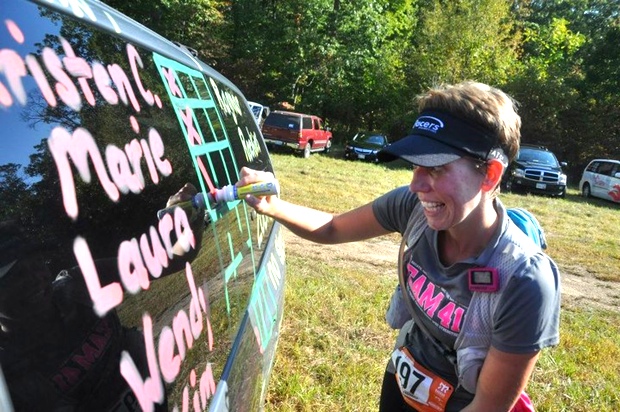I ran around a bend in the road, my eyes focused on the circle of white light in front of me that pierced the pitch-black and illuminated an ever-changing patch of asphalt. My feet slapped the street as I stumbled downhill, making the glow from my headlamp bounce. I reached the bottom, looked up at the road ahead, and finally saw a red light bouncing in the distance. Another runner!
For a few seconds, I forgot that this person was my competition and I should probably be trying to catch them. But when you’re running at 3 AM in a place so dark you have to wear a neon orange vest, it’s comforting to know you’re not the only one.
This past Saturday morning, I was one of the more than 300 people trotting half-blindly through rural Maryland, all of us on our second leg of the Ragnar Relay. It was day two of the Ragnar, a national racing series whose DC course runs from Cumberland, Maryland, to National Harbor. Each team consists of 12 runners (except for the “ultra” teams, who only have six), who run about 20 miles each over 36 hours or less, all for a T-shirt, a medal, and one free beer.
My team, like many others, traveled to the race in two vans, stuffed with people, extra socks, shirts, Gatorade, water, bagels, bananas, and whatever else could be eaten on the go. Everyone has a different start time to make sure teams of different ability finish near one another, and ours was 5:30 AM on Friday. (I was in the second van, so my group didn’t begin until the first six legs were done.) We rolled up to the sixth relay-exchange point, in the middle of a huge field covered with hundreds of 12-passenger vans, all painted with team slogans. Cowbells sounded every few seconds as runners came in to tag their teammates; one team trotted through in tutus, prompting laughter from onlookers.
We ran and ran, and as the sun sank into the horizon, people leaned their heads against car windows and closed their eyes, or whipped out sleeping bags, found a patch of ground, and passed out. When the car alarm next to them wouldn’t turn off or there were too many headlights streaking through the dark to fall asleep, people downed cans of Red Bull like water.
Caffeine pushed us into the gray morning, and a quick stop at Starbucks for some sausage, egg, and cheese sandwiches and coffee gave my squad a second wind. Bleary-eyed and hungry, we kept on until the man running our last leg rounded the final corner at the harbor and crossed the finish line. Then we all began searching for some greasy pizza.
While the race was a blast, there were a few things I wish I had thought about before I hopped in the van to head out:
1) If you’re going to bring food that needs to be refrigerated, eat that first. Otherwise you’ll open the cooler you stuffed your pasta salad in only to find it’s a tub of water and the salad has probably gone bad.
2) Don’t bother with butt lights if you don’t have to. At night, Ragnar requires all runners to have a headlamp, a vest, and a backlight. But a lot of headlamps come with a light that flashes on the back of your head, as well, so you can avoid having something slap against your back for the next six miles or so.
3) I forgot about hill training before the race, and my legs hated me for it. There are more than a few hills on the course, so try to run some before race day. (Need some tips? Try this hill interval workout.
4) Between your runs, you’re going to want to just sit—don’t. Sitting is good for a while, but if you lounge around in the car the whole time, your legs will stiffen and you’ll be running with rigid poles where functioning legs used to be. Get up every now and then, walk around, and stretch. You’ll thank yourself later.
5) I ran three legs of the race, totaling 21 miles. But the running distance varies for each participant, since people of all fitness levels join. That’s the whole point of running as a team.
For more information on the overnight relay, visit the Ragnar Relay Series website.












